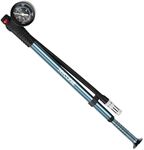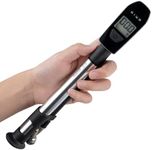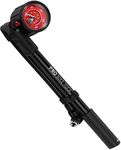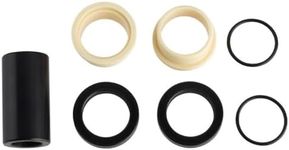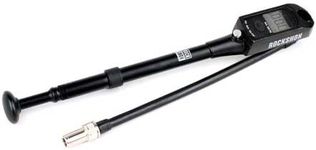Buying Guide for the Best MTB Shock Pumps
When it comes to mountain biking, having the right shock pump is essential for maintaining your bike's suspension system. A shock pump allows you to adjust the air pressure in your bike's suspension fork and rear shock, ensuring a smooth and controlled ride. Choosing the right shock pump involves understanding various specifications and how they align with your biking needs. Here are the key specs to consider when selecting a mountain bike shock pump.Pressure RangeThe pressure range of a shock pump indicates the maximum and minimum air pressure it can handle. This is important because different suspension systems require different pressure levels to function optimally. Typically, shock pumps have a pressure range of up to 300 PSI (pounds per square inch). For most mountain bikers, a pump with a range of 0-300 PSI will be sufficient. If you have a high-performance bike or ride in extreme conditions, you might need a pump with a higher pressure range. Choose a pump that matches the pressure requirements of your bike's suspension system.
Gauge AccuracyGauge accuracy refers to how precisely the pump can measure and display the air pressure. This is crucial for fine-tuning your suspension to achieve the desired performance. Shock pumps typically come with either analog or digital gauges. Analog gauges are generally easier to read at a glance, while digital gauges offer more precise readings. If you are a casual rider, an analog gauge with good readability should suffice. However, if you are a competitive rider or require precise adjustments, a digital gauge with high accuracy is recommended.
Build QualityThe build quality of a shock pump affects its durability and reliability. A well-built pump will last longer and perform better under various conditions. Look for pumps made from high-quality materials such as aluminum or steel, which are more durable than plastic. Additionally, check for features like a flexible hose and a sturdy handle, which can make the pump easier to use. If you frequently ride in rugged terrains, investing in a robust pump with excellent build quality is essential.
Valve CompatibilityValve compatibility refers to the types of valves the pump can connect to. Most mountain bike shocks use Schrader valves, so it is important to ensure that the pump you choose is compatible with Schrader valves. Some pumps also come with adapters for other valve types, which can be useful if you have different bikes with different valve systems. Make sure the pump you select is compatible with your bike's valve to avoid any inconvenience.
Ease of UseEase of use encompasses how user-friendly the pump is, including how easy it is to attach to the valve, read the gauge, and pump air. Features like a swivel hose, ergonomic handle, and a bleed valve for fine adjustments can enhance the usability of the pump. If you are new to mountain biking or prefer a hassle-free experience, look for a pump with these user-friendly features. Experienced riders might prioritize other specs, but ease of use is always a valuable consideration.
PortabilityPortability refers to how easy it is to carry the pump with you on rides. A compact and lightweight pump is ideal for bikers who need to make adjustments on the go. Some pumps are designed to be small enough to fit in a backpack or even a pocket. If you often go on long rides or bikepacking trips, a portable pump is a must-have. However, if you primarily make adjustments at home or in a workshop, portability might be less of a concern.



